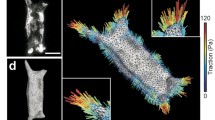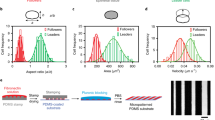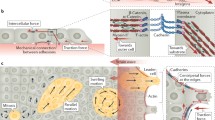Abstract
During the process of tissue formation and regeneration, cells migrate collectively while remaining connected through intercellular adhesions. However, the roles of cell–substrate and cell–cell mechanical interactions in regulating collective cell migration are still unclear. In this study, we employ a newly developed finite element cellular model to study collective cell migration by exploring the effects of mechanical feedback between cell and substrate and mechanical signal transmission between adjacent cells. Our viscoelastic model of cells consists many triangular elements and is of high resolution. Cadherin adhesion between cells is modeled explicitly as linear springs at subcellular level. In addition, we incorporate a mechano-chemical feedback loop between cell–substrate mechanics and Rac-mediated cell protrusion. Our model can reproduce a number of experimentally observed patterns of collective cell migration during wound healing, including cell migration persistence, separation distance between cell pairs and migration direction. Moreover, we demonstrate that cell protrusion determined by the cell–substrate mechanics plays an important role in guiding persistent and oriented collective cell migration. Furthermore, this guidance cue can be maintained and transmitted to submarginal cells of long distance through intercellular adhesions. Our study illustrates that our finite element cellular model can be employed to study broad problems of complex tissue in dynamic changes at subcellular level.







Similar content being viewed by others
References
Albert PJ, Schwarz US (2016) Dynamics of cell ensembles on adhesive micropatterns: bridging the gap between single cell spreading and collective cell migration. PLoS Comput Biol 12(4):e1004863
Alberts B (2008) Molecular biology of the cell: reference edition, number v. 1 in molecular biology of the cell: reference edition, Garland Science
Ansardamavandi A, Tafazzoli-Shadpour M, Shokrgozar MA (2018) Behavioral remodeling of normal and cancerous epithelial cell lines with differing invasion potential induced by substrate elastic modulus. Cell Adhesion Migr 12(5):472–488
Banerjee S, Marchetti MC (2012) Contractile stresses in cohesive cell layers on finite-thickness substrates. Phys Rev Lett 109(10):108101
Barnhart E, Lee K-C, Keren K, Mogilner A, Theriot J (2011) An adhesion-dependent switch between mechanisms that determine motile cell shape. PLoS Biol 9(5):e1001059
Basan M, Elgeti J, Hannezo E, Rappel W-J, Levine H (2013) Alignment of cellular motility forces with tissue flow as a mechanism for efficient wound healing. Proc Natl Acad Sci 110(7):2452–2459
Benjamin JM, Kwiatkowski AV, Yang C, Korobova F, Pokutta S, Svitkina T, Weis WI, Nelson WJ (2010) \(\alpha\)E-catenin regulates actin dynamics independently of cadherin-mediated cell–cell adhesion. J Cell Biol 189(2):339–352. https://doi.org/10.1083/jcb.200910041
Brugués A, Anon E, Conte V, Veldhuis JH, Gupta M, Colombelli J, Muñoz JJ, Brodland GW, Ladoux B, Trepat X (2014) Forces driving epithelial wound healing. Nat Phys 10(9):683–690. https://doi.org/10.1038/nphys3040
Chan CE, Odde DJ (2008) Traction dynamics of filopodia on compliant substrates. Science 322(5908):1687–1691. https://doi.org/10.1126/science.1163595
Changede R, Sheetz M (2017) Integrin and cadherin clusters: a robust way to organize adhesions for cell mechanics. BioEssays 39(1):1–12
Checa S, Rausch MK, Petersen A, Kuhl E, Duda GN (2015) The emergence of extracellular matrix mechanics and cell traction forces as important regulators of cellular self-organization. Biomech Model Mechanobiol 14(1):1–13. https://doi.org/10.1007/s10237-014-0581-9
Chernyavsky AI, Arredondo J, Marubio LM, Grando SA (2004) Differential regulation of keratinocyte chemokinesis and chemotaxis through distinct nicotinic receptor subtypes. J Cell Sci 117(23):5665–5679. https://doi.org/10.1242/jcs.01492
Cirit M, Krajcovic M, Choi CK, Welf ES, Horwitz AF, Haugh JM (2010) Stochastic model of integrin-mediated signaling and adhesion dynamics at the leading edges of migrating cells. PLoS Comput Biol 6(2):e1000688. https://doi.org/10.1371/journal.pcbi.1000688
Das T, Safferling K, Rausch S, Grabe N, Boehm H, Spatz JP (2015) A molecular mechanotransduction pathway regulates collective migration of epithelial cells. Nat Cell Biol 17(3):276. https://doi.org/10.1038/ncb3115
Defranco BH, Nickel BM, Baty CJ, Martinez JS, Gay VL, Sandulache VC, Hackam DJ, Murray SA (2008) Migrating cells retain gap junction plaque structure and function. Cell Commun Adhesion 15(3):273–288. https://doi.org/10.1080/15419060802198298
DiMilla P, Barbee K, Lauffenburger D (1991) Mathematical model for the effects of adhesion and mechanics on cell migration speed. Biophys J 60(1):15. https://doi.org/10.1016/S0006-3495(91)82027-6
Dokukina IV, Gracheva ME (2010) A model of fibroblast motility on substrates with different rigidities. Biophys J 98(12):2794–2803. https://doi.org/10.1016/j.bpj.2010.03.026
Drasdo D, Hoehme S (2012) Modeling the impact of granular embedding media, and pulling versus pushing cells on growing cell clones. New J Phys 14(5):055025. https://doi.org/10.1088/1367-2630/14/5/055025
Friedl P, Gilmour D (2009) Collective cell migration in morphogenesis, regeneration and cancer. Nat Rev Mol Cell Biol 10(7):445–457. https://doi.org/10.1038/nrm2720
Gardel ML, Sabass B, Ji L, Danuser G, Schwarz US (2008) Traction stress in focal adhesions correlates biphasically with actin retrograde flow speed. J Cell Biol. https://doi.org/10.1083/jcb.200810060
Hoehme S, Drasdo D (2010) A cell-based simulation software for multi-cellular systems. Bioinformatics 26(20):2641–2642. https://doi.org/10.1093/bioinformatics/btq437
Holle AW, Engler AJ (2011) More than a feeling: discovering, understanding, and influencing mechanosensing pathways. Curr Opin Biotechnol 22(5):648–654. https://doi.org/10.1016/j.copbio.2011.04.007
Hu S, Wang R, Tsang CM, Tsao SW, Sun D, Lam RH (2018) Revealing elasticity of largely deformed cells flowing along confining microchannels. RSC Adv 8(2):1030–1038. https://doi.org/10.1039/C7RA10750A
Hutson MS, Veldhuis J, Ma X, Lynch HE, Cranston PG, Brodland GW (2009) Combining laser microsurgery and finite element modeling to assess cell-level epithelial mechanics. Biophys J 97(12):3075–3085. https://doi.org/10.1016/j.bpj.2009.09.034
Jamali Y, Azimi M, Mofrad MR (2010) A sub-cellular viscoelastic model for cell population mechanics. PLoS ONE 5(8):e12097. https://doi.org/10.1371/journal.pone.0012097
Kabla AJ (2012) Collective cell migration: leadership, invasion and segregation. J R Soc Interface. https://doi.org/10.1098/rsif.2012.0448
Kachalo S, Naveed H, Cao Y, Zhao J, Liang J (2015) Mechanical model of geometric cell and topological algorithm for cell dynamics from single-cell to formation of monolayered tissues with pattern. PLoS ONE 10(5):e0126484. https://doi.org/10.1371/journal.pone.0126484
Karcher H, Lammerding J, Huang H, Lee RT, Kamm RD, Kaazempur-Mofrad MR (2003) A three-dimensional viscoelastic model for cell deformation with experimental verification. Biophys J 85(5):3336–3349. https://doi.org/10.1016/S0006-3495(03)74753-5
Kim JH, Serra-Picamal X, Tambe DT, Zhou EH, Park CY, Sadati M, Park J-A, Krishnan R, Gweon B, Millet E et al (2013) Propulsion and navigation within the advancing monolayer sheet. Nat Mater 12(9):856–863. https://doi.org/10.1038/nmat3689
Kim M-C, Silberberg YR, Abeyaratne R, Kamm RD, Asada HH (2018) Computational modeling of three-dimensional ECM-rigidity sensing to guide directed cell migration. Proc Natl Acad Sci. https://doi.org/10.1073/pnas.1717230115
Kim M-C, Whisler J, Silberberg YR, Kamm RD, Asada HH (2015) Cell invasion dynamics into a three dimensional extracellular matrix fibre network. PLoS Comput Biol 11(10):e1004535. https://doi.org/10.1371/journal.pcbi.1004535
Ladoux B, Mège R-M, Trepat X (2016) Front-rear polarization by mechanical cues: from single cells to tissues. Trends Cell Biol. https://doi.org/10.1016/j.tcb.2016.02.002
Lauffenburger DA, Horwitz AF (1996) Cell migration: a physically integrated molecular process. Cell 84(3):359–369. https://doi.org/10.1016/S0092-8674(00)81280-5
Lautscham LA, Kämmerer C, Lange JR, Kolb T, Mark C, Schilling A, Strissel PL, Strick R, Gluth C, Rowat AC et al (2015) Migration in confined 3D environments is determined by a combination of adhesiveness, nuclear volume, contractility, and cell stiffness. Biophys J 109(5):900–913. https://doi.org/10.1016/j.bpj.2015.07.025
Lee P, Wolgemuth CW (2011) Crawling cells can close wounds without purse strings or signaling. PLoS Comput Biol 7(3):e1002007. https://doi.org/10.1371/journal.pcbi.1002007
Lee RM, Yue H, Rappel W-J, Losert W (2017) Inferring single-cell behaviour from large-scale epithelial sheet migration patterns. J R Soc Interface 14(130):20170147. https://doi.org/10.1098/rsif.2017.0147
Leong C, Krishna V, Lim T, Ladoux B (2013) Geometrical constraints and physical crowding direct collective migration of fibroblasts. Commun Integr Biol 6(2):e23197. https://doi.org/10.4161/cib.23197
Li L, He Y, Zhao M, Jiang J (2015) Collective cell migration: implications for wound healing and cancer invasion. Burns Trauma 1(1):21. https://doi.org/10.4103/2321-3868.113331
Li Y, Bhimalapuram P, Dinner AR (2010) Model for how retrograde actin flow regulates adhesion traction stresses. J Phys Condens Matter 22(19):194113. https://doi.org/10.1088/0953-8984/22/19/194113
MacDonald A, Horwitz AR, Lauffenburger DA (2008) Kinetic model for lamellipodal actin-integrin clutch dynamics. Cell Adhesion Migr 2(2):95–105. https://doi.org/10.4161/cam.2.2.6210
Marée AF, Grieneisen VA, Hogeweg P (2007) The cellular Potts model and biophysical properties of cells, tissues and morphogenesis in Single-cell-based models in biology and medicine, Springer, pp 107–136. https://doi.org/10.1007/978-3-7643-8123-3_5
Maruthamuthu V, Sabass B, Schwarz US, Gardel ML (2011) Cell-ECM traction force modulates endogenous tension at cell–cell contacts. Proc Natl Acad Sci 108(12):4708–4713. https://doi.org/10.1073/pnas.1011123108
Maruthamuthu V, Gardel ML (2014) Protrusive activity guides changes in cell–cell tension during epithelial cell scattering. Biophys J 107(3):555–563. https://doi.org/10.1016/j.bpj.2014.06.028
Merchant B, Edelstein-Keshet L, Feng JJ (2018) A Rho-GTPase based model explains spontaneous collective migration of neural crest cell clusters. Dev Biol 444:S262–S273. https://doi.org/10.1016/j.ydbio.2018.01.013
Nagai T, Honda H (2009) Computer simulation of wound closure in epithelial tissues: cell-basal-lamina adhesion. Phys Rev E 80(6):061903. https://doi.org/10.1103/PhysRevE.80.061903
Nematbakhsh A, Sun W, Brodskiy PA, Amiri A, Narciso C, Xu Z, Zartman JJ, Alber M (2017) Multi-scale computational study of the mechanical regulation of cell mitotic rounding in epithelia. PLoS Comput Biol 13(5):e1005533. https://doi.org/10.1371/journal.pcbi.1005533
Ng MR, Besser A, Danuser G, Brugge JS (2012) Substrate stiffness regulates cadherin-dependent collective migration through myosin-ii contractility. J Cell Biol 199(3):545–563. https://doi.org/10.1083/jcb.201207148
Nikkhah M, Edalat F, Manoucheri S, Khademhosseini A (2012) Engineering microscale topographies to control the cell-substrate interface. Biomaterials 33(21):5230–5246. https://doi.org/10.1016/j.biomaterials.2012.03.079
Oakes P, Banerje S, Marchetti M, Gardel M (2014) Geometry regulates traction stresses in adherent cells. Biophys J 107:825–833. https://doi.org/10.1016/j.bpj.2014.06.045
Okada T, Lopez-Lago M, Giancotti FG (2005) Merlin/nf-2 mediates contact inhibition of growth by suppressing recruitment of rac to the plasma membrane. J Cell Biol 171(2):361–371. https://doi.org/10.1083/jcb.200503165
Ramirez-San Juan G, Oakes P, Gardel M (2017) Contact guidance requires spatial control of leading-edge protrusion. Mol Biol Cell 28(8):1043–1053. https://doi.org/10.1091/mbc.e16-11-0769
Rape AD, Guo W-H, Wang Y-L (2011) The regulation of traction force in relation to cell shape and focal adhesions. Biomaterials 32(8):2043–2051. https://doi.org/10.1016/j.biomaterials.2010.11.044
Rappel W-J, Edelstein-Keshet L (2017) Mechanisms of cell polarization. Curr Opin Syst Biol 3:43–53. https://doi.org/10.1016/j.coisb.2017.03.005
Ridley AJ, Schwartz MA, Burridge K, Firtel RA, Ginsberg MH, Borisy G, Parsons JT, Horwitz AR (2003) Cell migration: integrating signals from front to back. Science 302(5651):1704–1709. https://doi.org/10.1126/science.1092053
Rørth P (2007) Collective guidance of collective cell migration. Trends Cell Biol 17(12):575–579. https://doi.org/10.1016/j.tcb.2007.09.007
Rubinstein B, Fournier MF, Jacobson K, Verkhovsky AB, Mogilner A (2009) Actin-myosin viscoelastic flow in the keratocyte lamellipod. Biophys J 97(7):1853–1863. https://doi.org/10.1016/j.bpj.2009.07.020
Sandersius S, Weijer C, Newman T (2011) Emergent cell and tissue dynamics from subcellular modeling of active biomechanical processes. Phys Biol 8(4):045007. https://doi.org/10.1088/1478-3975/8/4/045007
Schoner JL, Lang J, Seidel H-P (2004) Measurement-based interactive simulation of viscoelastic solids in ‘Computer graphics forum’, vol 23, Wiley Online Library, pp 547–556. https://doi.org/10.1111/j.1467-8659.2004.00786.x
Schwartz J-M, Denninger M, Rancourt D, Moisan C, Laurendeau D (2005) Modelling liver tissue properties using a non-linear visco-elastic model for surgery simulation. Med Image Anal 9(2):103–112. https://doi.org/10.1016/j.media.2004.11.002
Sedef M, Samur E, Basdogan C (2006) Real-time finite-element simulation of linear viscoelastic tissue behavior based on experimental data. IEEE Comput Graph Appl 26(6):58–68. https://doi.org/10.1109/MCG.2006.135
Sheets K, Wunsch S, Ng C, Nain AS (2013) Shape-dependent cell migration and focal adhesion organization on suspended and aligned nanofiber scaffolds. Acta Biomater 9(7):7169–7177. https://doi.org/10.1016/j.actbio.2013.03.042
Stéphanou A, Mylona E, Chaplain M, Tracqui P (2008) A computational model of cell migration coupling the growth of focal adhesions with oscillatory cell protrusions. J Theor Biol 253(4):701–716. https://doi.org/10.1016/j.jtbi.2008.04.035
Tambe DT, Hardin CC, Angelini TE, Rajendran K, Park CY, Serra-Picamal X, Zhou EH, Zaman MH, Butler JP, Weitz DA et al (2011) Collective cell guidance by cooperative intercellular forces. Nat Mater 10(6):469–475. https://doi.org/10.1038/nmat3025
Trepat X, Wasserman MR, Angelini TE, Millet E, Weitz DA, Butler JP, Fredberg JJ (2009) Physical forces during collective cell migration. Nat Phys 5(6):426–430. https://doi.org/10.1038/nphys1269
Van Liedekerke P, Neitsch J, Johann T, Alessandri K, Nassoy P, Drasdo D (2019) Quantitative cell-based model predicts mechanical stress response of growing tumor spheroids over various growth conditions and cell lines. PLoS Comput Biol 15(3):e1006273. https://doi.org/10.1371/journal.pcbi.1006273
Vedula SRK, Hirata H, Nai MH, Toyama Y, Trepat X, Lim CT, Ladoux B et al (2014) Epithelial bridges maintain tissue integrity during collective cell migration. Nat Mater 13(1):87. https://doi.org/10.1038/nmat3814
Venhuizen J-H, Zegers MM (2017) Making heads or tails of it: cell–cell adhesion in cellular and supracellular polarity in collective migration. Cold Spring Harb Perspect Biol 9(11):a027854. https://doi.org/10.1101/cshperspect.a027854
Vermolen F, Gefen A (2015) Semi-stochastic cell-level computational modelling of cellular forces: application to contractures in burns and cyclic loading. Biomech Model Mechanobiol 14(6):1181–1195. https://doi.org/10.1007/s10237-015-0664-2
Vitorino P, Hammer M, Kim J, Meyer T (2011) A steering model of endothelial sheet migration recapitulates monolayer integrity and directed collective migration. Mol Cell Biol 31(2):342–350. https://doi.org/10.1128/MCB.00800-10
Watt F M, Green H (1981) Involucrin synthesis is correlated with cell size in human epidermal cultures. J Cell Biol 90(3):738–742
Watt FM, Huck WT (2013) Role of the extracellular matrix in regulating stem cell fate. Nat Rev Mol Cell Biol 14(8):467–473. https://doi.org/10.1038/nrm3620
Weber GF, Bjerke MA, DeSimone DW (2012) A mechanoresponsive cadherin-keratin complex directs polarized protrusive behavior and collective cell migration. Dev Cell 22(1):104–115. https://doi.org/10.1016/j.devcel.2011.10.013
Welf ES, Johnson HE, Haugh JM (2013) Bidirectional coupling between integrin-mediated signaling and actomyosin mechanics explains matrix-dependent intermittency of leading-edge motility. Mol Biol Cell 24(24):3945–3955. https://doi.org/10.1091/mbc.E13-06-0311
Wolf K, Te Lindert M, Krause M, Alexander S, Te Riet J, Willis AL, Hoffman RM, Figdor CG, Weiss SJ, Friedl P (2013) Physical limits of cell migration: control by ecm space and nuclear deformation and tuning by proteolysis and traction force. J Cell Biol 201(7):1069–1084. https://doi.org/10.1083/jcb.201210152
Wu YI, Frey D, Lungu OI, Jaehrig A, Schlichting I, Kuhlman B, Hahn KM (2009) A genetically encoded photoactivatable rac controls the motility of living cells. Nature 461(7260):104–108. https://doi.org/10.1038/nature08241
Yeh Y-C, Ling J-Y, Chen W-C, Lin H-H, Tang M-J (2017) Mechanotransduction of matrix stiffness in regulation of focal adhesion size and number: reciprocal regulation of caveolin-1 and \(\beta\)1 integrin. Sci Rep 7(1):15008. https://doi.org/10.1038/s41598-017-14932-6
Zhao J, Cao Y, DiPietro LA, Liang J (2017) Dynamic cellular finite-element method for modelling large-scale cell migration and proliferation under the control of mechanical and biochemical cues: a study of re-epithelialization. J R Soc Interface 14(129):20160959. https://doi.org/10.1098/rsif.2016.0959
Zhao J, Naveed H, Kachalo S, Cao Y, Tian W, Liang J (2013) Dynamic mechanical finite element model of biological cells for studying cellular pattern formation. In: 2013 35th Annual international conference of the IEEE engineering in Medicine and Biology Society (EMBC). IEEE, pp 4517–4520. https://doi.org/10.1109/EMBC.2013.6610551
Zielinski R, Mihai C, Kniss D, Ghadiali SN (2013) Finite element analysis of traction force microscopy: influence of cell mechanics, adhesion, and morphology. J Biomech Eng 135(7):071009. https://doi.org/10.1115/1.4024467
Author information
Authors and Affiliations
Corresponding author
Ethics declarations
Conflict of interest
The authors declare that they have no conflict of interest.
Additional information
Publosher's Note
Springer Nature remains neutral with regard to jurisdictional claims in published maps and institutional affiliations.
Electronic supplementary material
Below is the link to the electronic supplementary material.
Rights and permissions
About this article
Cite this article
Zhao, J., Manuchehrfar, F. & Liang, J. Cell–substrate mechanics guide collective cell migration through intercellular adhesion: a dynamic finite element cellular model. Biomech Model Mechanobiol 19, 1781–1796 (2020). https://doi.org/10.1007/s10237-020-01308-5
Received:
Accepted:
Published:
Issue Date:
DOI: https://doi.org/10.1007/s10237-020-01308-5




